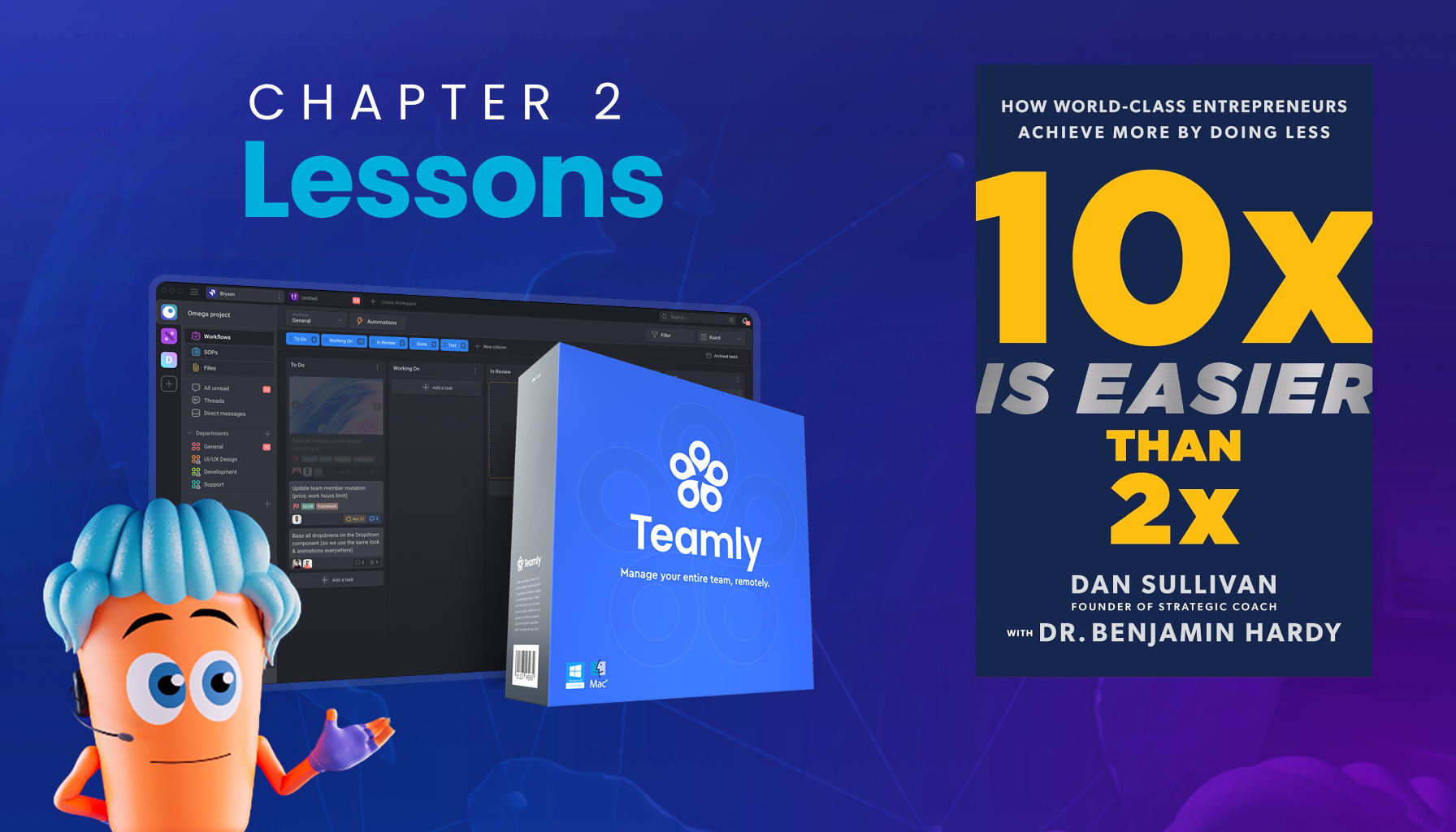
Click the button to start reading
Chapter 2 Insights: 10x Is Easier Than 2x
Chapter 2 of 10x Is Easier Than 2x wastes no time diving straight into a game-changing idea: that sometimes, it’s far simpler—and infinitely more rewarding—to pursue a massive breakthrough goal than it is to chase incremental improvements.
The premise seems counterintuitive at first. Yet the deeper this chapter goes, the clearer it becomes that focusing on a radical jump in quality, rather than quantity, can set in motion a wave of transformation unlike anything conventional thinking can deliver.

The Magnetic Pull of 10x Thinking
The heart of 10x thinking lies in allowing bigger, bolder goals to draw you out of your comfort zone.
Chapter 2 makes a strong case that aiming for small, incremental progress (2x growth) keeps individuals stuck in their old patterns, habits, and beliefs.
On the flip side, a 10x target demands a fresh approach and a more strategic use of time.
One of the most striking concepts from this chapter is that chasing 10x doesn’t require more energy but rather a shift in focus. Instead of juggling 100 smaller pursuits, readers are encouraged to hone in on the 20% of activities that truly matter.
This invites a cleaner, clearer path forward. There’s a definite magnetism to the idea that we can achieve massive results by laser-targeting the work that aligns with a higher vision.
Shedding the Weight of the 80%
A recurring theme of Chapter 2 is “shedding”—an intentional process of letting go of the 80% of tasks, habits, and even relationships that no longer serve a bigger goal.
Many people resist this because it means leaving behind what’s familiar. Yet the chapter underscores that clinging to outdated approaches drags down potential and stalls progress.
The loss-aversion principle comes into play here.
Humans tend to hang on to what they know, even when it’s not optimal, for fear of regretting the change.
This chapter demolishes that inertia by illustrating real-world examples of entrepreneurs who took a hard look at their commitments and bravely cut the activities that didn’t drive exponential results. The bottom line is that tight focus unleashes creativity, frees up time for strategic thinking, and paves the way for a bigger leap.

Embracing a New Identity and Standards
Central to the 10x journey is an identity transformation. Chapter 2 posits that one’s daily behavior ties directly to personal identity.
If a person identifies as a “dabbler,” the results remain scattered and hesitant. If that same person chooses to elevate their standards—committing fully to a new, more focused self-image—then 10x success becomes feasible.
The book highlights the 4 C’s Formula—Commitment, Courage, Capability, Confidence—as a road map for anyone aiming to embrace that new identity. By first committing to an audacious goal, the individual steps outside the safe boundaries of what’s known.
Courage grows from pushing through discomfort, leading to new skills and capabilities. That, in turn, yields confidence in the new identity and fosters an environment of continuous progress.
Jimmy Donaldson’s Masterclass in Focus
An especially vivid illustration in Chapter 2 is Jimmy Donaldson, also known as MrBeast. His approach to creating viral, high-quality YouTube content reveals how exponential thinking can reshape an industry.
Rather than aiming for a slow, linear increase in views and followers, he singled out the strategic activities that mattered most—crafting the best possible content—and delegated anything that fell outside that zone of genius.
Donaldson’s success story confirms that spending time on high-value tasks unlocks extraordinary returns.
A small improvement in video quality—say a 10% bump—can lead to a surge in audience engagement that’s far beyond 10%. The secret lies in devoting near-obsessive attention to excellence.
Chapter 2 encourages readers to replicate this model in their own fields by isolating the aspects of their work that produce exponential value and then fearlessly shedding the clutter.

The Strength of Quality Over Quantity
The book challenges a widely held assumption that success is merely a function of pouring in more hours or performing more tasks.
Instead, Chapter 2 suggests that exponential growth relies on a higher level of quality in the few essential activities that genuinely move the needle. This notion resonates with the story of companies that, rather than broadening their product lines, decided to refine fewer offerings.
Consider the example of Kimberly-Clark’s leadership under Darwin Smith. The move to shut down paper mills and invest heavily in consumer products like Kleenex was a direct leap to a higher-value opportunity.
It wasn’t about expanding production capabilities in every direction; it was about doing fewer things remarkably well. The principle is clear: a well-honed focus on quality in the 20% that counts is the engine of 10x growth.
Letting Go to Level Up
Chapter 2 reinforces that the biggest obstacle to exponential change is often an unwillingness to let go of the past.
Readers learn about the sunk-cost fallacy, which keeps people tethered to what they’ve already invested in, even when that path is no longer viable. To make the leap from 2x to 10x, individuals must develop a keen sense of which activities have outlived their usefulness.
The sense of loss that accompanies quitting a familiar path can be unsettling. Yet the message is unambiguous: refusing to release the good things in life can prevent achieving the great.
This idea has profound implications beyond business strategy—it can inform choices about relationships, habits, and broader life goals.

The Delegation Advantage
No discussion of 10x thinking is complete without acknowledging the critical role of delegation.
Chapter 2 delivers a clear directive: delegate or outsource the 80% so that leaders and innovators can focus on their “genius zone.”
A perfect example is James Clear’s method during the writing of Atomic Habits, in which he leveraged a personal assistant for day-to-day tasks.
By handing off lower-priority work, Clear created the space to go deeper into research, writing, and refinement, resulting in a book that soared to the top of the nonfiction bestsellers list.
Teamly software, a project management tool that offers streamlined oversight of tasks and collaboration, can be particularly helpful in this regard.
Solutions like Teamly allow entrepreneurs to maintain focus on what matters most while entrusting routine tasks to capable teams.
The Iteration Mindset
Another standout segment in Chapter 2 discusses the power of iteration in the journey to 10x results.
Rather than aiming for perfection on the first pass, the chapter highlights how incremental refinements compound into significant improvements.
James Clear, for instance, performed annual reviews to assess his work, scrupulously identifying areas that needed tweaking.
This deep-dive approach fosters a learning environment where every success and stumble feeds into a feedback loop. Chapter 2 paints iteration not as a chore but as an exciting avenue for relentless excellence.
The more often you can refine your craft, the closer you get to a genuinely world-class output. It’s an energizing message that pulls readers toward the idea that every step forward, every test, and every pivot helps generate an increasingly refined end result.

Why 10x Is Actually Easier Than 2x
Chapter 2 confronts a common question head-on: how can striving for something significantly larger be easier?
The explanation revolves around the concept that extraordinary goals demand a different kind of thinking. When the goal is enormous, small tactics and half-measures are no longer enough. This forces a singular, robust strategy that cuts through distractions.
For instance, solving a $30 million problem typically involves one well-crafted solution. Trying to solve a series of minor $100,000 problems can devolve into chaos, with each minor issue requiring separate attention.
By funneling attention toward one breakthrough project, the mind can generate innovative ideas. The competitive field also thins at the top.
While many people battle over incremental gains, fewer go all-in for a revolutionary leap—paradoxically making that leap more accessible to those who dare.
Putting Chapter 2 into Action
Chapter 2 leaves readers with a simple but powerful call to action: define the 20% that is vital and let go of the 80% that isn’t.
That advice resonates across industries and even personal life decisions. By framing the pursuit of a big goal as the central event, individuals can rally their focus, organize their resources, and spark a transformation in how they operate.
Such a transformation often entails resetting personal standards to a higher bar. This can feel daunting initially, especially when it requires quitting comfortable routines.
But the lesson is clear—growth at this level demands a reevaluation of identity and the courage to part ways with methods that no longer align. There’s a refreshing sense of freedom in that process.
Rather than feeling deprived by cutting out unnecessary tasks, readers find themselves invigorated by the creative energy that arises once the clutter is gone.
For those looking to revolutionize their goals and daily approach, Chapter 2 of 10x Is Easier Than 2x serves as a standout guide.
The framework it lays out—focus on a tighter list of priorities, delegate wisely, adopt a higher personal standard, and iterate methodically—offers a repeatable blueprint for astounding outcomes.
It’s the kind of advice that, once taken to heart, reshapes both thinking and behavior in ways that persist long after the final page is turned.
Ready to explore these ideas in more depth? Grab your copy here
10x Is Easier Than 2x on Amazon
















